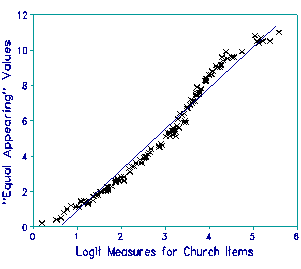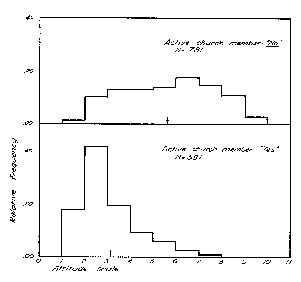
L. L. Thurstone: "The scale values represented by the 45 statements [concerning Attitude toward the church are shown in the Figure], the purpose of which is to show that the 45 statements represent a more or less evenly graduated series of scale-values. The upper two horizontal lines constitute the scale proper and between these lines are small cross lines. Each of these cross lines represents the location of one of the 45 opinions. There are 45 such cross lines. The class intervals on the scale and their numerical designations are immediately below." (p.59)

"Having adopted an origin of measurement which is assigned arbitrarily at one end of the series of available opinions, and having a unit of measurement, the equal-appearing interval, we can proceed to ascertain the mean-scale value of all the opinions that any individual indorses." (p.64)
Thurstone, L.L. & Chave, E.J. (1929). The Measurement of Attitude. Chicago: University of Chicago Press.
Thurstone & Chave progressed far towards constructing a linear scale with the method of "equal-appearing" intervals. The scatterplot shows the relationship between the scale values of all 130 of their items (including the 45 above) and the logit values obtained by a Rasch analysis of their data (ibid. p. 33-4). They also advanced toward conjoint measurement. Below is their histogram map (p. 74) of the mean-scale values for two samples. Though both maps use the same scale, they fail to interpret respondent scale position in terms of the item hierarchy.
John Michael Linacre


Thurstone's Minimalist Maps Linacre, J.M. … Rasch Measurement Transactions, 1999, 13:3 p. 699
| Forum | Rasch Measurement Forum to discuss any Rasch-related topic |
Go to Top of Page
Go to index of all Rasch Measurement Transactions
AERA members: Join the Rasch Measurement SIG and receive the printed version of RMT
Some back issues of RMT are available as bound volumes
Subscribe to Journal of Applied Measurement
Go to Institute for Objective Measurement Home Page. The Rasch Measurement SIG (AERA) thanks the Institute for Objective Measurement for inviting the publication of Rasch Measurement Transactions on the Institute's website, www.rasch.org.
| Coming Rasch-related Events | |
|---|---|
| Jan. 16 - Feb. 13, 2025, Fri.-Fri. | On-line workshop: Rasch Measurement - Core Topics (E. Smith, Winsteps), www.statistics.com |
| Apr. 8 - Apr. 11, 2026, Wed.-Sat. | National Council for Measurement in Education - Los Angeles, CA, ncme.org/events/2026-annual-meeting |
| Apr. 8 - Apr. 12, 2026, Wed.-Sun. | American Educational Research Association - Los Angeles, CA, www.aera.net/AERA2026 |
| May. 15 - June 12, 2026, Fri.-Fri. | On-line workshop: Rasch Measurement - Core Topics (E. Smith, Winsteps), www.statistics.com |
| June 19 - July 25, 2026, Fri.-Sat. | On-line workshop: Rasch Measurement - Further Topics (E. Smith, Winsteps), www.statistics.com |
The URL of this page is www.rasch.org/rmt/rmt133a.htm
Website: www.rasch.org/rmt/contents.htm